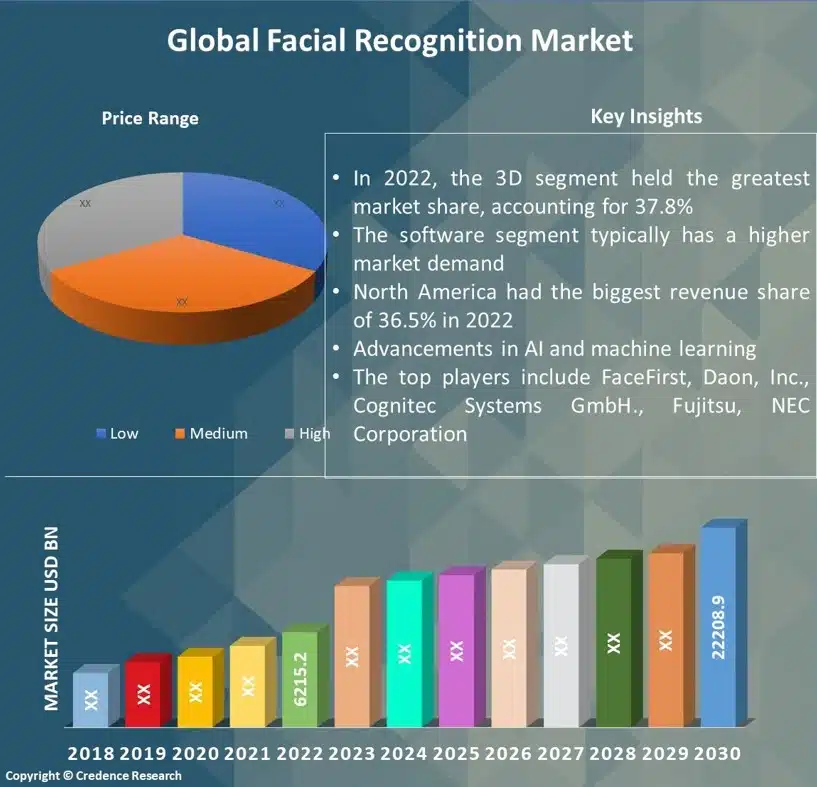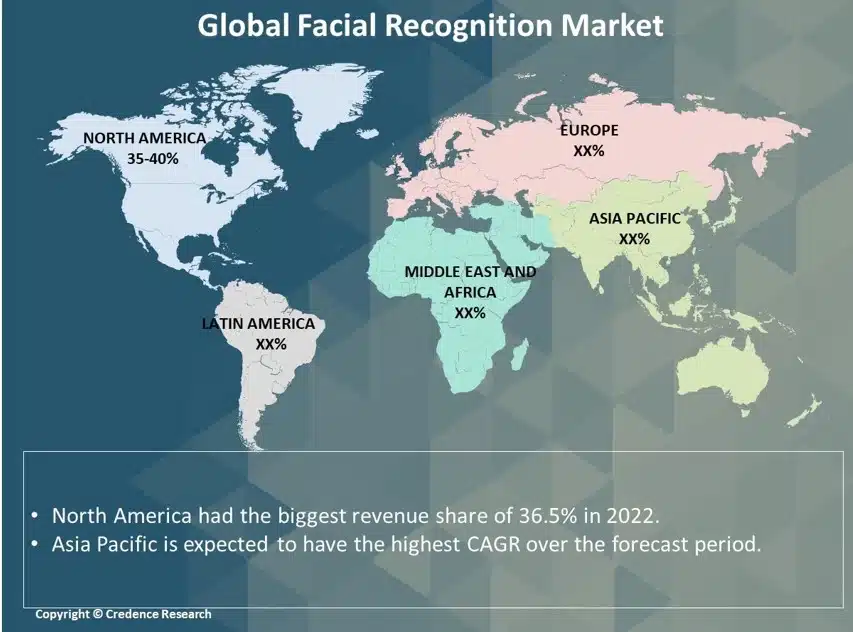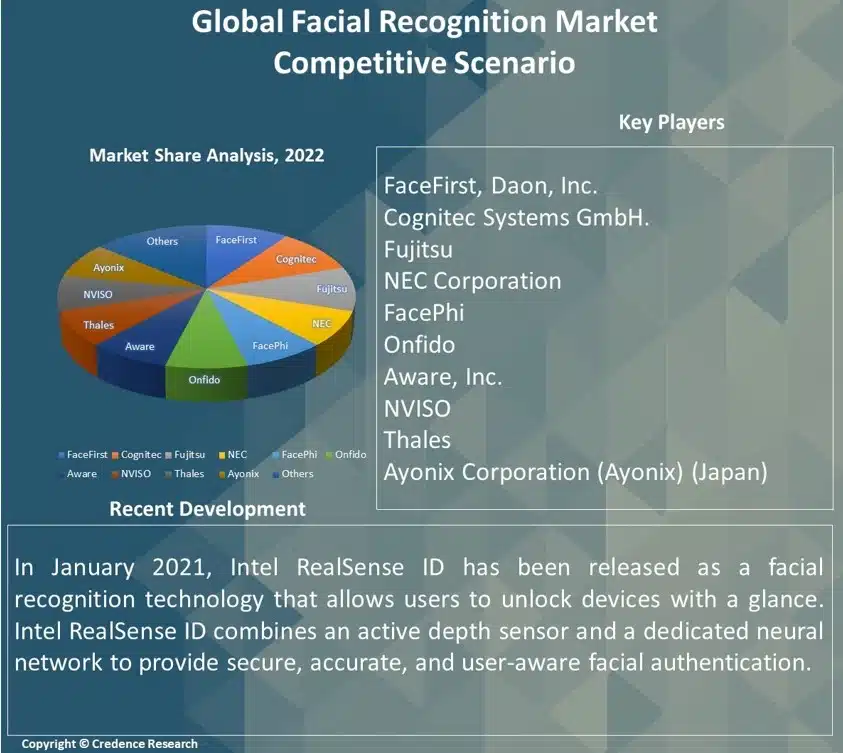CHAPTER NO. 1 : INTRODUCTION 18
1.1. Report Description 18
Purpose of the Report 18
USP & Key Offerings 18
1.2. Key Benefits for Stakeholders 18
1.3. Target Audience 19
1.4. Report Scope 19
CHAPTER NO. 2 : EXECUTIVE SUMMARY 20
2.1. Global Facial Recognition Market Snapshot 20
2.2. Global Facial Recognition Market, 2018 – 2032 (USD Million) 21
CHAPTER NO. 3 : GLOBAL FACIAL RECOGNITION MARKET – INDUSTRY ANALYSIS 22
3.1. Introduction 22
3.2. Market Drivers 23
3.3. Driving Factor 1 Analysis 23
3.4. Driving Factor 2 Analysis 24
3.5. Market Restraints 25
3.6. Restraining Factor Analysis 25
3.7. Market Opportunities 26
3.8. Market Opportunity Analysis 26
3.9. Porter’s Five Forces Analysis 27
CHAPTER NO. 4 : ANALYSIS COMPETITIVE LANDSCAPE 28
4.1. Company Market Share Analysis – 2023 28
4.1.1. Global Facial Recognition Market: Company Market Share, by Volume, 2023 28
4.1.2. Global Facial Recognition Market: Company Market Share, by Revenue, 2023 29
4.1.3. Global Facial Recognition Market: Top 6 Company Market Share, by Revenue, 2023 29
4.1.4. Global Facial Recognition Market: Top 3 Company Market Share, by Revenue, 2023 30
4.2. Global Facial Recognition Market Company Revenue Market Share, 2023 31
4.3. Company Assessment Metrics, 2023 32
4.3.1. Stars 32
4.3.2. Emerging Leaders 32
4.3.3. Pervasive Players 32
4.3.4. Participants 32
4.4. Start-ups /SMEs Assessment Metrics, 2023 32
4.4.1. Progressive Companies 32
4.4.2. Responsive Companies 32
4.4.3. Dynamic Companies 32
4.4.4. Starting Blocks 32
4.5. Strategic Developments 33
4.5.1. Acquisitions & Mergers 33
New Product Launch 33
Global Expansion 33
4.6. Key Players Product Matrix 34
CHAPTER NO. 5 : PESTEL & ADJACENT MARKET ANALYSIS 35
5.1. PESTEL 35
5.1.1. Political Factors 35
5.1.2. Economic Factors 35
5.1.3. Social Factors 35
5.1.4. Technological Factors 35
5.1.5. Environmental Factors 35
5.1.6. Legal Factors 35
5.2. Adjacent Market Analysis 35
CHAPTER NO. 6 : GLOBAL FACIAL RECOGNITION MARKET – BY APPLICATION SEGMENT ANALYSIS 36
6.1. Global Facial Recognition Market Overview, by Application Segment 36
6.1.1. Global Facial Recognition Market Revenue Share, By Application, 2023 & 2032 37
6.1.2. Global Facial Recognition Market Attractiveness Analysis, By Application 38
6.1.3. Incremental Revenue Growth Opportunity, by Application, 2024 – 2032 38
6.1.4. Global Facial Recognition Market Revenue, By Application, 2018, 2023, 2027 & 2032 39
6.2. Emotion Recognition 40
6.3. Attendance Tracking and Monitoring 41
6.4. Access Control 42
6.5. Security & Surveillance 43
6.6. Others 44
CHAPTER NO. 7 : GLOBAL FACIAL RECOGNITION MARKET – BY END-USE SEGMENT ANALYSIS 45
7.1. Global Facial Recognition Market Overview, by End-use Segment 45
7.1.1. Global Facial Recognition Market Revenue Share, By End-use, 2023 & 2032 46
7.1.2. Global Facial Recognition Market Attractiveness Analysis, By End-use 47
7.1.3. Incremental Revenue Growth Opportunity, by End-use, 2024 – 2032 47
7.1.4. Global Facial Recognition Market Revenue, By End-use, 2018, 2023, 2027 & 2032 48
7.2. BFSI 49
7.3. Automobile & Transportation 50
7.4. Telecom & IT 51
7.5. Healthcare 52
7.6. Others 53
CHAPTER NO. 8 : GLOBAL FACIAL RECOGNITION MARKET – BY TECHNOLOGY SEGMENT ANALYSIS 54
8.1. Global Facial Recognition Market Overview, by Technology Segment 54
8.1.1. Global Facial Recognition Market Revenue Share, By Technology, 2023 & 2032 55
8.1.2. Global Facial Recognition Market Attractiveness Analysis, By Technology 56
8.1.3. Incremental Revenue Growth Opportunity, by Technology, 2024 – 2032 56
8.1.4. Global Facial Recognition Market Revenue, By Technology, 2018, 2023, 2027 & 2032 57
8.2. 2D 58
8.3. 3D 59
8.4. Facial Analytics 60
CHAPTER NO. 9 : GLOBAL FACIAL RECOGNITION MARKET – GLOBAL ANALYSIS 61
9.1. Application 61
9.1.1. Global Facial Recognition Market Revenue, By Application, 2018 – 2023 (USD Million) 61
9.1.2. Global Facial Recognition Market Revenue, By Application, 2024 – 2032 (USD Million) 61
9.2. End-use 62
9.2.1. Global Facial Recognition Market Revenue, By End-use, 2018 – 2023 (USD Million) 62
9.2.2. Global Facial Recognition Market Revenue, By End-use, 2024 – 2032 (USD Million) 62
9.3. Technology 63
9.3.1. Global Facial Recognition Market Revenue, By Technology, 2018 – 2023 (USD Million) 63
9.3.2. Global Facial Recognition Market Revenue, By Technology, 2024 – 2032 (USD Million) 63
CHAPTER NO. 10 : FACIAL RECOGNITION MARKET – NORTH AMERICA 64
10.1. North America 64
10.1.1. Key Highlights 64
10.1.2. North America Facial Recognition Market Revenue, By Country, 2018 – 2023 (USD Million) 65
10.1.3. North America Facial Recognition Market Revenue, By Application, 2018 – 2023 (USD Million) 66
10.1.4. North America Facial Recognition Market Revenue, By End-use, 2018 – 2023 (USD Million) 67
10.1.5. North America Facial Recognition Market Revenue, By Technology, 2018 – 2023 (USD Million) 68
10.2. U.S. 69
10.3. Canada 69
10.4. Mexico 69
CHAPTER NO. 11 : FACIAL RECOGNITION MARKET – EUROPE 70
11.1. Europe 70
11.1.1. Key Highlights 70
11.1.2. Europe Facial Recognition Market Revenue, By Country, 2018 – 2023 (USD Million) 71
11.1.3. Europe Facial Recognition Market Revenue, By Application, 2018 – 2023 (USD Million) 72
11.1.4. Europe Facial Recognition Market Revenue, By End-use, 2018 – 2023 (USD Million) 73
11.1.5. Europe Facial Recognition Market Revenue, By Technology, 2018 – 2023 (USD Million) 74
11.2. UK 75
11.3. France 75
11.4. Germany 75
11.5. Italy 75
11.6. Spain 75
11.7. Russia 75
11.8. Belgium 75
11.9. Netherland 75
11.10. Austria 75
11.11. Sweden 75
11.12. Poland 75
11.13. Denmark 75
11.14. Switzerland 75
11.15. Rest of Europe 75
CHAPTER NO. 12 : FACIAL RECOGNITION MARKET – ASIA PACIFIC 76
12.1. Asia Pacific 76
12.1.1. Key Highlights 76
12.1.2. Asia Pacific Facial Recognition Market Revenue, By Country, 2018 – 2023 (USD Million) 77
12.1.3. Asia Pacific Facial Recognition Market Revenue, By Application, 2018 – 2023 (USD Million) 78
12.1.4. Asia Pacific Facial Recognition Market Revenue, By End-use, 2018 – 2023 (USD Million) 79
12.1.5. Asia Pacific Facial Recognition Market Revenue, By Technology, 2018 – 2023 (USD Million) 80
12.2. China 81
12.3. Japan 81
12.4. South Korea 81
12.5. India 81
12.6. Australia 81
12.7. Thailand 81
12.8. Indonesia 81
12.9. Vietnam 81
12.10. Malaysia 81
12.11. Philippines 81
12.12. Taiwan 81
12.13. Rest of Asia Pacific 81
CHAPTER NO. 13 : FACIAL RECOGNITION MARKET – LATIN AMERICA 82
13.1. Latin America 82
13.1.1. Key Highlights 82
13.1.2. Latin America Facial Recognition Market Revenue, By Country, 2018 – 2023 (USD Million) 83
13.1.3. Latin America Facial Recognition Market Revenue, By Application, 2018 – 2023 (USD Million) 84
13.1.4. Latin America Facial Recognition Market Revenue, By End-use, 2018 – 2023 (USD Million) 85
13.1.5. Latin America Facial Recognition Market Revenue, By Technology, 2018 – 2023 (USD Million) 86
13.2. Brazil 87
13.3. Argentina 87
13.4. Peru 87
13.5. Chile 87
13.6. Colombia 87
13.7. Rest of Latin America 87
CHAPTER NO. 14 : FACIAL RECOGNITION MARKET – MIDDLE EAST 88
14.1. Middle East 88
14.1.1. Key Highlights 88
14.1.2. Middle East Facial Recognition Market Revenue, By Country, 2018 – 2023 (USD Million) 89
14.1.3. Middle East Facial Recognition Market Revenue, By Application, 2018 – 2023 (USD Million) 90
14.1.4. Middle East Facial Recognition Market Revenue, By End-use, 2018 – 2023 (USD Million) 91
14.1.5. Middle East Facial Recognition Market Revenue, By Technology, 2018 – 2023 (USD Million) 92
14.2. UAE 93
14.3. KSA 93
14.4. Israel 93
14.5. Turkey 93
14.6. Iran 93
14.7. Rest of Middle East 93
CHAPTER NO. 15 : FACIAL RECOGNITION MARKET – AFRICA 94
15.1. Africa 94
15.1.1. Key Highlights 94
15.1.2. Africa Facial Recognition Market Revenue, By Country, 2018 – 2023 (USD Million) 95
15.1.3. Africa Facial Recognition Market Revenue, By Application, 2018 – 2023 (USD Million) 96
15.1.4. Africa Facial Recognition Market Revenue, By End-use, 2018 – 2023 (USD Million) 97
15.1.5. Africa Facial Recognition Market Revenue, By Technology, 2018 – 2023 (USD Million) 98
15.2. Egypt 99
15.3. Nigeria 99
15.4. Algeria 99
15.5. Morocco 99
15.6. Rest of Africa 99
CHAPTER NO. 16 : COMPANY PROFILES 100
16.1. Aware, Inc. 100
16.1.1. Company Overview 100
16.1.2. Product Portfolio 100
16.1.3. Swot Analysis 100
16.1.4. Business Strategy 101
16.1.5. Financial Overview 101
16.2. Cognitec Systems GmbH 102
16.3. Ayonix Corporation 102
16.4. Thales Group 102
16.5. Fujitsu 102
16.6. FacePhi Biometria SA 102
16.7. NEC Corporation 102
16.8. Onfido 102
16.9. TECH5 102
16.10. Panasonic Corporation 102
16.11. Animetrics Inc. 102
16.12. Face First Inc. 102
16.13. Idemia France 102
16.14. Daon Inc. 102
CHAPTER NO. 17 : RESEARCH METHODOLOGY 103
17.1. Research Methodology 103
17.2. Phase I – Secondary Research 104
17.3. Phase II – Data Modeling 104
Company Share Analysis Model 105
Revenue Based Modeling 105
17.4. Phase III – Primary Research 106
17.5. Research Limitations 107
Assumptions 107
List of Figures
FIG NO. 1. Global Facial Recognition Market Revenue, 2018 – 2032 (USD Million) 21
FIG NO. 2. Porter’s Five Forces Analysis for Global Facial Recognition Market 27
FIG NO. 3. Company Share Analysis, 2023 28
FIG NO. 4. Company Share Analysis, 2023 29
FIG NO. 5. Company Share Analysis, 2023 29
FIG NO. 6. Company Share Analysis, 2023 30
FIG NO. 7. Global Facial Recognition Market – Company Revenue Market Share, 2023 31
FIG NO. 8. Global Facial Recognition Market Revenue Share, By Application, 2023 & 2032 37
FIG NO. 9. Market Attractiveness Analysis, By Application 38
FIG NO. 10. Incremental Revenue Growth Opportunity by Application, 2024 – 2032 38
FIG NO. 11. Global Facial Recognition Market Revenue, By Application, 2018, 2023, 2027 & 2032 39
FIG NO. 12. Global Facial Recognition Market for Emotion Recognition, Revenue (USD Million) 2018 – 2032 40
FIG NO. 13. Global Facial Recognition Market for Attendance Tracking and Monitoring, Revenue (USD Million) 2018 – 2032 41
FIG NO. 14. Global Facial Recognition Market for Access Control, Revenue (USD Million) 2018 – 2032 42
FIG NO. 15. Global Facial Recognition Market for Security & Surveillance, Revenue (USD Million) 2018 – 2032 43
FIG NO. 16. Global Facial Recognition Market for Others, Revenue (USD Million) 2018 – 2032 44
FIG NO. 17. Global Facial Recognition Market Revenue Share, By End-use, 2023 & 2032 46
FIG NO. 18. Market Attractiveness Analysis, By End-use 47
FIG NO. 19. Incremental Revenue Growth Opportunity by End-use, 2024 – 2032 47
FIG NO. 20. Global Facial Recognition Market Revenue, By End-use, 2018, 2023, 2027 & 2032 48
FIG NO. 21. Global Facial Recognition Market for BFSI, Revenue (USD Million) 2018 – 2032 49
FIG NO. 22. Global Facial Recognition Market for Automobile & Transportation, Revenue (USD Million) 2018 – 2032 50
FIG NO. 23. Global Facial Recognition Market for Telecom & IT, Revenue (USD Million) 2018 – 2032 51
FIG NO. 24. Global Facial Recognition Market for Healthcare, Revenue (USD Million) 2018 – 2032 52
FIG NO. 25. Global Facial Recognition Market for Others, Revenue (USD Million) 2018 – 2032 53
FIG NO. 26. Global Facial Recognition Market Revenue Share, By Technology, 2023 & 2032 55
FIG NO. 27. Market Attractiveness Analysis, By Technology 56
FIG NO. 28. Incremental Revenue Growth Opportunity by Technology, 2024 – 2032 56
FIG NO. 29. Global Facial Recognition Market Revenue, By Technology, 2018, 2023, 2027 & 2032 57
FIG NO. 30. Global Facial Recognition Market for 2D, Revenue (USD Million) 2018 – 2032 58
FIG NO. 31. Global Facial Recognition Market for 3D, Revenue (USD Million) 2018 – 2032 59
FIG NO. 32. Global Facial Recognition Market for Facial Analytics, Revenue (USD Million) 2018 – 2032 60
FIG NO. 33. North America Facial Recognition Market Revenue, 2018 – 2032 (USD Million) 64
FIG NO. 34. Europe Facial Recognition Market Revenue, 2018 – 2032 (USD Million) 70
FIG NO. 35. Asia Pacific Facial Recognition Market Revenue, 2018 – 2032 (USD Million) 76
FIG NO. 36. Latin America Facial Recognition Market Revenue, 2018 – 2032 (USD Million) 82
FIG NO. 37. Middle East Facial Recognition Market Revenue, 2018 – 2032 (USD Million) 88
FIG NO. 38. Africa Facial Recognition Market Revenue, 2018 – 2032 (USD Million) 94
FIG NO. 39. Research Methodology – Detailed View 103
FIG NO. 40. Research Methodology 104
List of Tables
TABLE NO. 1. : Global Facial Recognition Market: Snapshot 20
TABLE NO. 2. : Drivers for the Global Facial Recognition Market: Impact Analysis 23
TABLE NO. 3. : Restraints for the Global Facial Recognition Market: Impact Analysis 25
TABLE NO. 4. : Global Facial Recognition Market Revenue, By Application, 2018 – 2023 (USD Million) 61
TABLE NO. 5. : Global Facial Recognition Market Revenue, By Application, 2024 – 2032 (USD Million) 61
TABLE NO. 6. : Global Facial Recognition Market Revenue, By End-use, 2018 – 2023 (USD Million) 62
TABLE NO. 7. : Global Facial Recognition Market Revenue, By End-use, 2024 – 2032 (USD Million) 62
TABLE NO. 8. : Global Facial Recognition Market Revenue, By Technology, 2018 – 2023 (USD Million) 63
TABLE NO. 9. : Global Facial Recognition Market Revenue, By Technology, 2024 – 2032 (USD Million) 63
TABLE NO. 10. : North America Facial Recognition Market Revenue, By Country, 2018 – 2023 (USD Million) 65
TABLE NO. 11. : North America Facial Recognition Market Revenue, By Country, 2024 – 2032 (USD Million) 65
TABLE NO. 12. : North America Facial Recognition Market Revenue, By Application, 2018 – 2023 (USD Million) 66
TABLE NO. 13. : North America Facial Recognition Market Revenue, By Application, 2024 – 2032 (USD Million) 66
TABLE NO. 14. : North America Facial Recognition Market Revenue, By End-use, 2018 – 2023 (USD Million) 67
TABLE NO. 15. : North America Facial Recognition Market Revenue, By End-use, 2024 – 2032 (USD Million) 67
TABLE NO. 16. : North America Facial Recognition Market Revenue, By Technology, 2018 – 2023 (USD Million) 68
TABLE NO. 17. : North America Facial Recognition Market Revenue, By Technology, 2024 – 2032 (USD Million) 68
TABLE NO. 18. : Europe Facial Recognition Market Revenue, By Country, 2018 – 2023 (USD Million) 71
TABLE NO. 19. : Europe Facial Recognition Market Revenue, By Country, 2024 – 2032 (USD Million) 71
TABLE NO. 20. : Europe Facial Recognition Market Revenue, By Application, 2018 – 2023 (USD Million) 72
TABLE NO. 21. : Europe Facial Recognition Market Revenue, By Application, 2024 – 2032 (USD Million) 72
TABLE NO. 22. : Europe Facial Recognition Market Revenue, By End-use, 2018 – 2023 (USD Million) 73
TABLE NO. 23. : Europe Facial Recognition Market Revenue, By End-use, 2024 – 2032 (USD Million) 73
TABLE NO. 24. : Europe Facial Recognition Market Revenue, By Technology, 2018 – 2023 (USD Million) 74
TABLE NO. 25. : Europe Facial Recognition Market Revenue, By Technology, 2024 – 2032 (USD Million) 74
TABLE NO. 26. : Asia Pacific Facial Recognition Market Revenue, By Country, 2018 – 2023 (USD Million) 77
TABLE NO. 27. : Asia Pacific Facial Recognition Market Revenue, By Country, 2024 – 2032 (USD Million) 77
TABLE NO. 28. : Asia Pacific Facial Recognition Market Revenue, By Application, 2018 – 2023 (USD Million) 78
TABLE NO. 29. : Asia Pacific Facial Recognition Market Revenue, By Application, 2024 – 2032 (USD Million) 78
TABLE NO. 30. : Asia Pacific Facial Recognition Market Revenue, By End-use, 2018 – 2023 (USD Million) 79
TABLE NO. 31. : Asia Pacific Facial Recognition Market Revenue, By End-use, 2024 – 2032 (USD Million) 79
TABLE NO. 32. : Asia Pacific Facial Recognition Market Revenue, By Technology, 2018 – 2023 (USD Million) 80
TABLE NO. 33. : Asia Pacific Facial Recognition Market Revenue, By Technology, 2024 – 2032 (USD Million) 80
TABLE NO. 34. : Latin America Facial Recognition Market Revenue, By Country, 2018 – 2023 (USD Million) 83
TABLE NO. 35. : Latin America Facial Recognition Market Revenue, By Country, 2024 – 2032 (USD Million) 83
TABLE NO. 36. : Latin America Facial Recognition Market Revenue, By Application, 2018 – 2023 (USD Million) 84
TABLE NO. 37. : Latin America Facial Recognition Market Revenue, By Application, 2024 – 2032 (USD Million) 84
TABLE NO. 38. : Latin America Facial Recognition Market Revenue, By End-use, 2018 – 2023 (USD Million) 85
TABLE NO. 39. : Latin America Facial Recognition Market Revenue, By End-use, 2024 – 2032 (USD Million) 85
TABLE NO. 40. : Latin America Facial Recognition Market Revenue, By Technology, 2018 – 2023 (USD Million) 86
TABLE NO. 41. : Latin America Facial Recognition Market Revenue, By Technology, 2024 – 2032 (USD Million) 86
TABLE NO. 42. : Middle East Facial Recognition Market Revenue, By Country, 2018 – 2023 (USD Million) 89
TABLE NO. 43. : Middle East Facial Recognition Market Revenue, By Country, 2024 – 2032 (USD Million) 89
TABLE NO. 44. : Middle East Facial Recognition Market Revenue, By Application, 2018 – 2023 (USD Million) 90
TABLE NO. 45. : Middle East Facial Recognition Market Revenue, By Application, 2024 – 2032 (USD Million) 90
TABLE NO. 46. : Middle East Facial Recognition Market Revenue, By End-use, 2018 – 2023 (USD Million) 91
TABLE NO. 47. : Middle East Facial Recognition Market Revenue, By End-use, 2024 – 2032 (USD Million) 91
TABLE NO. 48. : Middle East Facial Recognition Market Revenue, By Technology, 2018 – 2023 (USD Million) 92
TABLE NO. 49. : Middle East Facial Recognition Market Revenue, By Technology, 2024 – 2032 (USD Million) 92
TABLE NO. 50. : Africa Facial Recognition Market Revenue, By Country, 2018 – 2023 (USD Million) 95
TABLE NO. 51. : Africa Facial Recognition Market Revenue, By Country, 2024 – 2032 (USD Million) 95
TABLE NO. 52. : Africa Facial Recognition Market Revenue, By Application, 2018 – 2023 (USD Million) 96
TABLE NO. 53. : Africa Facial Recognition Market Revenue, By Application, 2024 – 2032 (USD Million) 96
TABLE NO. 54. : Africa Facial Recognition Market Revenue, By End-use, 2018 – 2023 (USD Million) 97
TABLE NO. 55. : Africa Facial Recognition Market Revenue, By End-use, 2024 – 2032 (USD Million) 97
TABLE NO. 56. : Africa Facial Recognition Market Revenue, By Technology, 2018 – 2023 (USD Million) 98
TABLE NO. 57. : Africa Facial Recognition Market Revenue, By Technology, 2024 – 2032 (USD Million) 98










